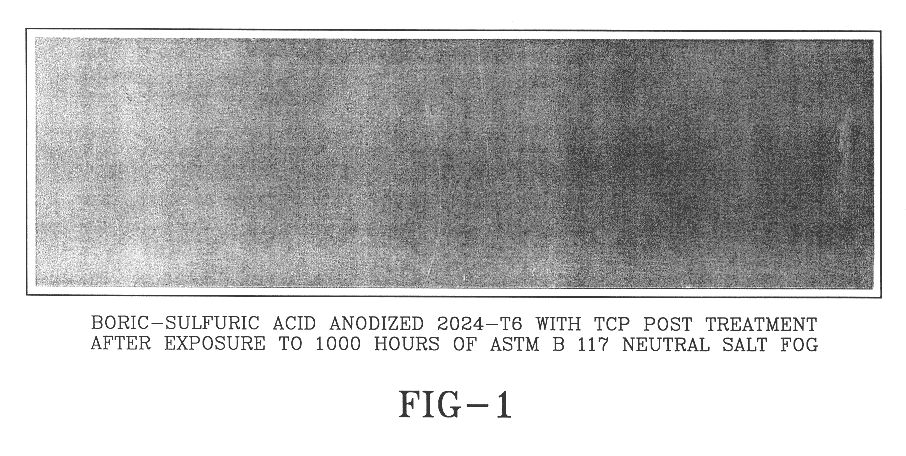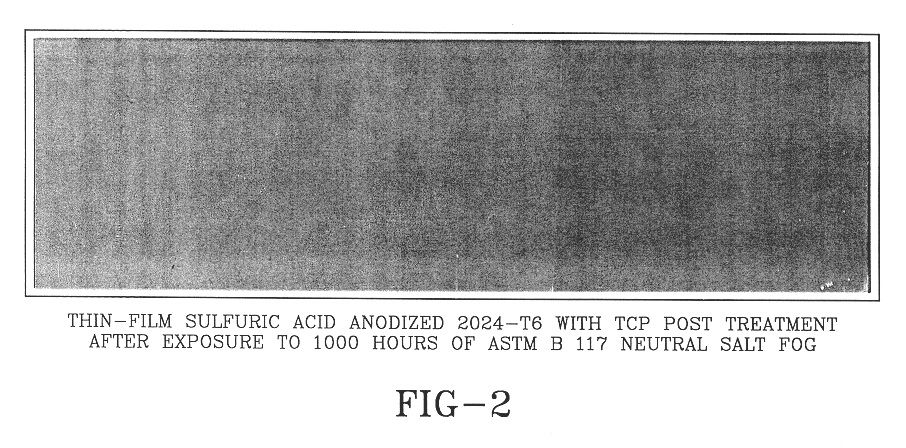Post-treatment for anodized aluminum
a post-treatment and anodized aluminum technology, applied in the direction of anti-corrosion paints, solid-state diffusion coatings, coatings, etc., can solve the problems of high toxicity of hexavalent chromium, toxic solutions used to deposit protective coatings, and the coating per se, so as to corrosion resistance, and corrosion resistance characteristics, and improve the adhesion bonding and adhesion bonding properties. , the effect of improving
- Summary
- Abstract
- Description
- Claims
- Application Information
AI Technical Summary
Benefits of technology
Problems solved by technology
Method used
Image
Examples
example 2
An acidic aqueous solution having a pH of 3.7 to 4.0 for post-treating aluminum and its alloys to improve adhesion bonding and corrosion-resistant which comprises, per liter of solution, from about 0.01 to 22 grams of trivalent chromium sulfate, about 0.01 to 12 grams of potassium hexafluorozirconate, about 0.01 to 12 grams of potassium tetrafluoroborate and from about 0.5 to 1.5 grams of methylcellulose thickener.
example 3
An acidic aqueous solution having a pH ranging from 3.7 to 4.0 for post-treating anodized aluminum and its alloys to improve adhesion bonding and corrosion-resistant which comprises, per liter of solution, from about 4.0 to 8.0 grams of trivalent potassium-chromium sulfate (KCr(SO.sub.4).sub.2), about 6 to 10 grams of potassium hexafluorozirconate about 0.01 to 12 grams of potassium hexafluorosilicate and from about 0.5 to 1.5 grams of methylcellulose thickener.
example 4
A preferred method of preparing the acidic solution comprises mixing about 0.01 to 22 grams per liter of solution of chromium III sulfate and preferably about 6.0 grams per liter with about 0.01 to 12 grams per liter of solution of potassium hexafluorozirconate, preferably about 8.0 grams per liter in distilled or deionized water. The composition is ready to use after a dwell of 24 hours, most preferably after the pH of the solution has risen between 3.7 and 4.0. About 0.1 weight percent of Methocel F4M, or about 1.0 gram per liter is used for optimum performance. The addition of potassium tetrafluoroborate and / or potassium hexafluorosilicate ranges from 0.01 grams per liter up to their solubility limit. Preferably, the addition is about 50% by weight of the fluorosilicate based on the weight of fluorozirconate. About 1.0 to 10 weight percent of the fluoroborate salt is added based on the amount of the flurozirconate salt. More preferably, about 3.0 weight percent of potassium tetra...
PUM
| Property | Measurement | Unit |
|---|---|---|
| temperatures | aaaaa | aaaaa |
| concentration | aaaaa | aaaaa |
| pH | aaaaa | aaaaa |
Abstract
Description
Claims
Application Information
 Login to View More
Login to View More - R&D
- Intellectual Property
- Life Sciences
- Materials
- Tech Scout
- Unparalleled Data Quality
- Higher Quality Content
- 60% Fewer Hallucinations
Browse by: Latest US Patents, China's latest patents, Technical Efficacy Thesaurus, Application Domain, Technology Topic, Popular Technical Reports.
© 2025 PatSnap. All rights reserved.Legal|Privacy policy|Modern Slavery Act Transparency Statement|Sitemap|About US| Contact US: help@patsnap.com



